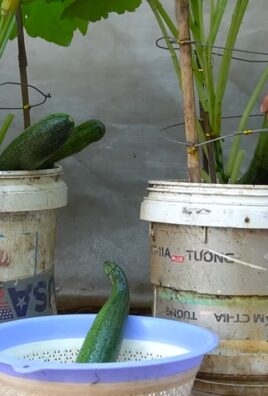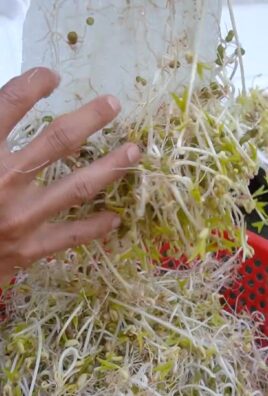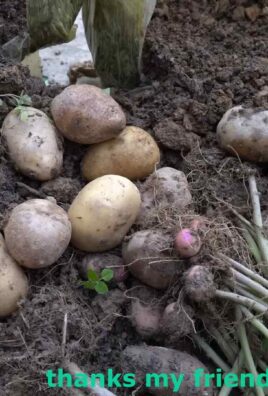Easy Tomato Gardening – sounds like a dream, right? I know, I know, you’ve probably tried growing tomatoes before, only to be met with spindly plants, blossom end rot, or a disappointing harvest. But trust me, with a few clever tricks and DIY hacks, you can transform your backyard (or even your balcony!) into a tomato-growing paradise.
For centuries, tomatoes have been a staple in cuisines around the world, from the vibrant sauces of Italy to the refreshing salsas of Mexico. Originating in South America, these juicy fruits (yes, they’re technically fruits!) have become a symbol of summer and fresh, homegrown goodness. But let’s be honest, achieving that “homegrown goodness” can sometimes feel like a battle against pests, diseases, and unpredictable weather.
That’s where this article comes in! I’m going to share my favorite easy tomato gardening secrets – the kind of tips and tricks that seasoned gardeners swear by, but are simple enough for even a complete beginner to master. We’ll cover everything from choosing the right varieties for your climate to building simple DIY supports and concocting natural pest control solutions. Why spend a fortune on bland, store-bought tomatoes when you can enjoy the unparalleled flavor of your own homegrown bounty? Let’s get our hands dirty and unlock the secrets to a thriving tomato garden!

DIY Tomato Gardening: From Seed to Sauce (Almost!)
Okay, so you want to grow your own tomatoes? Awesome! I’m here to tell you, it’s totally doable, even if you think you have a black thumb. I’ve been there, trust me. This guide will walk you through everything, from starting seeds indoors to (hopefully!) harvesting juicy, delicious tomatoes. Let’s get started!
Phase 1: Starting Your Tomato Seeds Indoors
This is where the magic begins! Starting seeds indoors gives you a head start on the growing season, especially if you live in a place with shorter summers like I do.
What You’ll Need:
* Tomato seeds (choose your favorite varieties!)
* Seed starting trays or small pots (I like the ones with drainage holes)
* Seed starting mix (this is different from regular potting soil – it’s lighter and better for delicate seedlings)
* Spray bottle with water
* Heat mat (optional, but helpful for germination)
* Grow light (essential if you don’t have a super sunny windowsill)
* Small labels and a permanent marker
Step-by-Step Instructions:
1. Prepare Your Seed Starting Trays: Fill each cell or pot with seed starting mix. Gently tap the tray to settle the mix, but don’t pack it down too hard. You want the roots to be able to grow easily.
2. Sow Your Seeds: Make a small indentation (about ¼ inch deep) in the center of each cell. I usually use the eraser end of a pencil for this. Drop 2-3 seeds into each indentation. This increases your chances of at least one seed germinating.
3. Cover the Seeds: Gently cover the seeds with more seed starting mix. Lightly pat it down.
4. Water Thoroughly: Use your spray bottle to gently mist the soil until it’s evenly moist. You don’t want to soak it, just dampen it.
5. Label Everything: This is crucial! Trust me, you’ll forget which variety is which if you don’t label them. Write the tomato variety and the date on each label and stick it in the corresponding cell or pot.
6. Provide Warmth: Place your seed starting trays on a heat mat. This will help the seeds germinate faster. If you don’t have a heat mat, a warm spot in your house will work too.
7. Provide Light: Place your grow light a few inches above the seed starting trays. If you’re using a windowsill, make sure it gets at least 6-8 hours of direct sunlight per day. Rotate the trays regularly to prevent the seedlings from leaning towards the light.
8. Maintain Moisture: Keep the soil consistently moist, but not soggy. Check the soil daily and mist with water as needed.
9. Wait Patiently: Germination usually takes 5-10 days, depending on the tomato variety and the temperature.
10. Thin the Seedlings: Once the seedlings have their first set of true leaves (the leaves that look like tiny tomato leaves, not the initial seed leaves), thin them out by snipping off the weaker seedlings at the soil line with small scissors. Leave only the strongest seedling in each cell. This gives the remaining seedling plenty of room to grow.
Phase 2: Caring for Your Tomato Seedlings
Now that your seeds have sprouted, it’s time to nurture those little guys!
What You’ll Need:
* Grow light
* Water
* Liquid fertilizer (specifically formulated for seedlings)
* Small fan (optional, but helpful for strengthening stems)
Step-by-Step Instructions:
1. Maintain Light: Keep your grow light on for 14-16 hours per day. Adjust the height of the light as the seedlings grow, keeping it a few inches above the top of the plants.
2. Water Carefully: Water the seedlings when the top inch of soil feels dry to the touch. Avoid overwatering, as this can lead to root rot.
3. Fertilize Regularly: Start fertilizing your seedlings with a diluted liquid fertilizer about once a week. Follow the instructions on the fertilizer label. I usually use a half-strength solution to avoid burning the delicate seedlings.
4. Provide Air Circulation: If you have a small fan, place it near the seedlings to provide gentle air circulation. This will help strengthen their stems and prevent fungal diseases.
5. “Harden Off” Your Seedlings: About a week before you plan to transplant your seedlings outdoors, you need to “harden them off.” This means gradually exposing them to outdoor conditions to help them adjust to the sun, wind, and temperature changes. Start by placing them outdoors in a sheltered spot for an hour or two each day, gradually increasing the amount of time they spend outdoors. Bring them back inside at night.
Phase 3: Transplanting Your Tomato Seedlings Outdoors
This is a big step! Make sure the weather is right before you transplant.
What You’ll Need:
* Your hardened-off tomato seedlings
* Gardening gloves
* Trowel or shovel
* Tomato cages or stakes
* Compost or well-rotted manure
* Watering can or hose
* Mulch (straw, wood chips, or shredded leaves)
Step-by-Step Instructions:
1. Choose the Right Location: Tomatoes need at least 6-8 hours of direct sunlight per day. Choose a location in your garden that gets plenty of sun. Also, make sure the soil is well-draining.
2. Prepare the Soil: Dig a hole that is slightly larger than the root ball of your tomato seedling. Mix some compost or well-rotted manure into the soil you removed from the hole. This will provide the seedlings with extra nutrients.
3. Plant Deep: This is a trick I learned from my grandma! Plant your tomato seedlings deep, burying the stem up to the first set of leaves. Tomatoes can grow roots along their stems, so planting them deep will help them develop a stronger root system.
4. Remove Lower Leaves: Before planting, gently remove the lower leaves from the stem that will be buried. This will prevent them from rotting and attracting pests.
5. Gently Remove Seedling: Carefully remove the seedling from its pot or cell. Gently loosen the roots if they are tightly packed.
6. Place in Hole: Place the seedling in the hole and backfill with the amended soil. Gently pat the soil around the base of the plant.
7. Water Thoroughly: Water the newly transplanted seedlings thoroughly.
8. Add Support: Install tomato cages or stakes around each plant. This will help support the plants as they grow and prevent the fruit from touching the ground. I prefer cages because they offer more support as the plant gets bigger.
9. Mulch: Apply a layer of mulch around the base of the plants. This will help retain moisture, suppress weeds, and regulate soil temperature.
Phase 4: Caring for Your Tomato Plants Outdoors
The hard work is done, but the care continues!
What You’ll Need:
* Watering can or hose
* Tomato fertilizer
* Pruning shears
* Pest control (organic options are best!)
Step-by-Step Instructions:
1. Water Regularly: Water your tomato plants deeply and regularly, especially during hot, dry weather. Aim to water at the base of the plant to avoid wetting the leaves, which can lead to fungal diseases.
2. Fertilize: Fertilize your tomato plants every 2-3 weeks with a tomato fertilizer. Follow the instructions on the fertilizer label.
3. Prune: Prune your tomato plants regularly to remove suckers (the small shoots that grow between the main stem and the branches). This will help improve air circulation and encourage the plant to focus its energy on producing fruit. I usually prune suckers when they are small, about 2-3 inches long.
4. Monitor for Pests and Diseases: Keep an eye out for pests and diseases. Common tomato pests include aphids, tomato hornworms, and whiteflies. Common tomato diseases include early blight, late blight, and blossom end rot. If you spot any problems, take action immediately. There are many organic pest control and disease control options available. For example, you can spray your plants with a solution of neem oil to control aphids and other pests.
5. Support the Plants: As the plants grow, make sure they are adequately supported by the cages or stakes. You may need to tie the plants to the supports with twine.
Phase 5: Harvesting Your Tomatoes
The moment you’ve been waiting for!
What You’ll Need:
* Your own two hands!
* Basket or container
Step-by-Step Instructions:
1. Look for Ripe Tomatoes: Tomatoes are ripe when they are fully colored and slightly soft to the touch. The color will depend

Conclusion
So, there you have it! Transforming your gardening experience with this simple, yet incredibly effective, DIY trick for easy tomato gardening. We’ve walked you through the process, highlighting how this method can save you time, reduce water consumption, and ultimately, lead to a more bountiful and delicious tomato harvest.
Why is this a must-try? Because it addresses some of the most common challenges faced by tomato gardeners, especially beginners. It simplifies watering, ensuring deep root hydration and minimizing the risk of fungal diseases caused by wet foliage. It also provides a slow-release fertilizer system, delivering essential nutrients directly to the roots where they are needed most. This translates to healthier, stronger plants that are better equipped to withstand pests and diseases, and produce more tomatoes.
But don’t just take our word for it! The beauty of this DIY approach is its adaptability. Feel free to experiment with different materials for your watering containers. Recycled plastic bottles work wonderfully, but you could also use clay pots or even repurposed buckets, depending on the size of your tomato plants and your aesthetic preferences.
Consider adding different types of organic fertilizers to your watering containers. Bone meal is excellent for promoting strong root development and blossom end rot prevention, while Epsom salts can provide a boost of magnesium, which is crucial for chlorophyll production and overall plant health. You can also tailor the fertilizer mix to the specific needs of your tomato variety. Heirloom tomatoes, for example, might benefit from a slightly different nutrient balance than hybrid varieties.
Another variation to explore is the placement of the watering containers. While burying them directly next to the tomato plant is the most common method, you could also experiment with placing them slightly further away, creating a wider zone of hydration. This might be particularly beneficial in areas with sandy soil that drains quickly.
We are confident that this DIY trick will revolutionize your tomato gardening efforts. It’s a sustainable, cost-effective, and incredibly rewarding way to grow your own delicious, homegrown tomatoes.
Now, it’s your turn! We wholeheartedly encourage you to give this easy tomato gardening method a try. We’re eager to hear about your experiences, your successes, and any variations you discover along the way. Share your photos and stories in the comments section below. Let’s build a community of thriving tomato gardeners, all benefiting from this simple yet powerful technique. Happy gardening!
Frequently Asked Questions (FAQ)
What type of container is best for the watering system?
The best type of container depends on your preferences and what you have readily available. Recycled plastic bottles (like 2-liter soda bottles) are a popular and eco-friendly choice. Clay pots are another excellent option, as they allow for some breathability and can add a touch of rustic charm to your garden. Buckets can be used for larger tomato plants or if you want to create a larger reservoir of water. Regardless of the material, ensure the container is clean and free of any harmful chemicals. Also, make sure to drill enough holes to allow for adequate water flow.
How often should I refill the watering containers?
The frequency of refilling depends on several factors, including the weather, the size of your tomato plants, and the type of soil you have. In hot, sunny weather, you may need to refill the containers every day or two. In cooler, cloudier weather, you may only need to refill them every few days. Check the soil moisture around the base of the tomato plant regularly. If the soil feels dry to the touch, it’s time to refill the containers. Over time, you’ll develop a sense of how often your plants need watering based on your local conditions.
What type of fertilizer should I use in the watering containers?
You can use a variety of organic fertilizers in the watering containers. Compost tea is a great option, as it provides a balanced blend of nutrients and beneficial microbes. Fish emulsion is another excellent choice, as it’s rich in nitrogen, which is essential for leafy growth. Bone meal is a good source of phosphorus, which promotes strong root development and blossom end rot prevention. Epsom salts can provide a boost of magnesium, which is crucial for chlorophyll production. You can also use a slow-release granular fertilizer, but be sure to choose one that is specifically formulated for tomatoes. Always follow the instructions on the fertilizer packaging to avoid over-fertilizing.
Can I use this method for other plants besides tomatoes?
Yes, this method can be adapted for other plants that benefit from deep watering and consistent nutrient delivery. Peppers, eggplants, and squash are all good candidates. However, you may need to adjust the size of the watering containers and the type of fertilizer you use based on the specific needs of the plant. For example, peppers may benefit from a fertilizer that is higher in phosphorus and potassium, while squash may require more nitrogen.
What if the holes in the container get clogged?
Clogging can occur if you’re using a fertilizer that contains particulate matter or if the soil is particularly heavy. To prevent clogging, use a fertilizer that is well-dissolved or filtered. You can also wrap the container in landscape fabric before burying it to prevent soil from entering the holes. If the holes do become clogged, you can try using a small wire or toothpick to clear them. Alternatively, you can remove the container, clean it thoroughly, and rebury it.
Is this method suitable for container gardening?
Yes, this method is perfectly suitable for container gardening. In fact, it can be even more effective in containers, as it helps to ensure that the soil stays consistently moist and that the plants receive a steady supply of nutrients. Choose a container that is large enough to accommodate the mature size of your tomato plant. You may also need to adjust the size of the watering container based on the size of the container.
How does this method help prevent blossom end rot?
Blossom end rot is a common problem in tomatoes that is caused by a calcium deficiency. This DIY watering method helps to prevent blossom end rot by ensuring that the tomato plants receive a consistent supply of water and nutrients, including calcium. By delivering water directly to the roots, this method helps to prevent fluctuations in soil moisture, which can interfere with calcium uptake. Adding bone meal to the watering containers can also provide an extra boost of calcium.
What are the benefits of deep watering for tomatoes?
Deep watering encourages the development of strong, deep roots, which makes the plants more drought-tolerant and better able to access nutrients from the soil. It also helps to prevent fungal diseases by keeping the foliage dry. When you water from above, the leaves can stay wet for extended periods, creating a favorable environment for fungal growth. Deep watering, on the other hand, delivers water directly to the roots, minimizing the risk of fungal infections.
How does this method save water?
This method saves water by delivering water directly to the roots of the tomato plants, minimizing water loss through evaporation and runoff. When you water from above, a significant portion of the water can evaporate before it even reaches the roots. This method also helps to prevent overwatering, as the plants only take up the water they need.
Can I use this method in raised garden beds?
Absolutely! This DIY watering system works wonderfully in raised garden beds. The controlled watering and nutrient delivery are just as beneficial in raised beds as they are in traditional gardens. Just ensure the containers are appropriately sized for the bed and the plants.




Leave a Comment